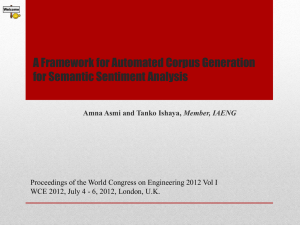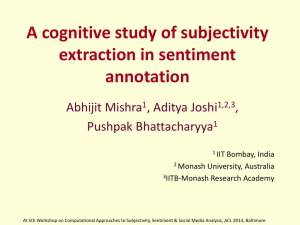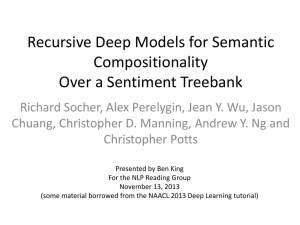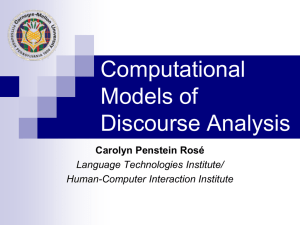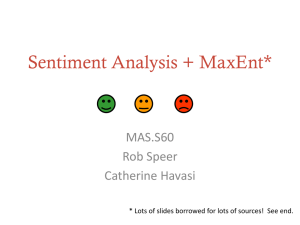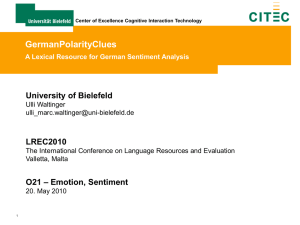Sentiment…Human Intelligence
advertisement
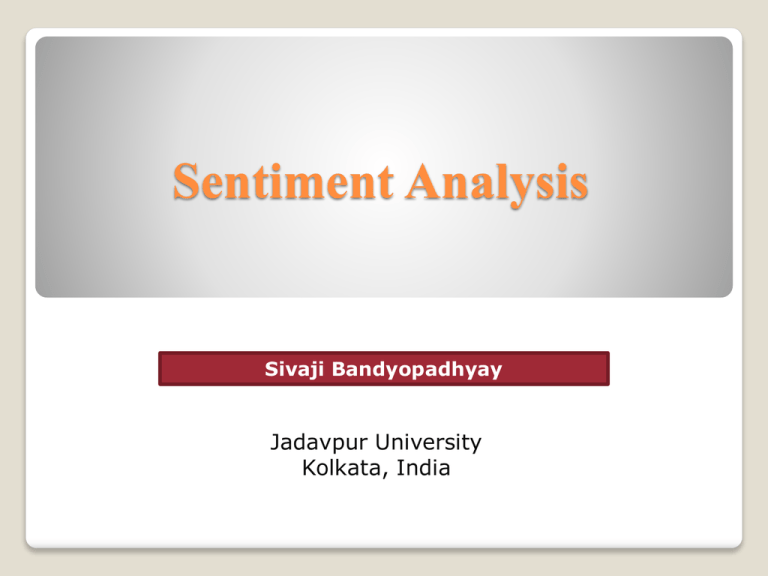
Sentiment Analysis Sivaji Bandyopadhyay Jadavpur University Kolkata, India Sentiment…Human Intelligence Overview Sentiment Analysis is a multifaceted problem Sentiment Knowledge Acquisition Sentiment / Subjectivity Detection Sentiment Polarity Detection Sentiment Structurization Sentiment Summary Sentiment Knowledge Acquisition Involving Human Intelligence Prior Polarity Sentiment Lexicon Automatic Computational Processes WordNet Dictionary Based Antonym Involving Human Intelligence Dr Sentiment Cross Lingual Projection of Sentiment Lexicons Sentiment Analysis IITH is a very good institution. I love Hyderabad, the city is famous for its Biriyani, Pearl and old Mughal architecture! Summer in Hyderabad is too scorching. Sentiment Analysis Sentiment Detection Sentiment Classification Andrea Esuli and Fabrizio Sebastiani. SentiWordNet: A publicly available lexical resource for opinion mining. In Proceedings of Language Resources and Evaluation (LREC), 2006. 4 What is SentiWordNet? Prior Polarity Lexicon POS Offset Positivity Negativity Synset Adjective 1006361 0.875 0.0 happy Noun 4466580 0.375 0.0 friendliness Adverb 214589 0.625 0.125 sharply Verb 2471993 0.0 0.125 shame 5 Prior Polarity Lexicon Sentiment Bearing Words: love, hate, good, favorite Challenges for Polarity Identification: Context Information (Pang et al., 2002) Domain Pragmatic Knowledge (Aue and Gamon, 2005) Time Dimension (Read, 2005) Language/Culture Properties (Wiebe and Mihalcea, 2006) 6 Continue….(2) Prior Polarity Lexicon Context Information I prefer Limuzin as it is longer than Mercedes. Avoid longer baggage during excursion in Amazon. Language/Culture Properties सहे रा (Sahera: A marriage-wear of India) দুর্গ াপু জ া (Durgapujo: A festival of Bengal) Domain Pragmatic Knowledge Sensex go high. Price go high. Time Dimension During 90’s mobile phone users generally reported in various online reviews about their color-phones but in recent times color-phone is not just enough. People are fascinated and influenced by touch screen and various software(s) installation facilities on these new generation gadgets. 7 Continue….(3) Prior Polarity Lexicon Suppose total occurrence of a word “long” in a domain corpus is n. The positive and negative occurrence of that word are Sp and Sn respectively. Therefore in a developed sentiment lexicon the assigned positivity and negativity score of that word will be as follows: Positivity Negativity : : Sp /n Sn /n These associative positive and negative scores are called prior polarity. 8 Source Lexicon Acquisition Available Resources for English SentiWordNet (Esuli et. al., 2006) SentiWordNet is an automatically constructed lexical resource for English that assigns a positivity score and a negativity score to each WordNet synset. WordNet Affect List (Strapparava et al., 2004) WordNet synsets tagged with six basic emotions: anger, disgust, fear, joy, sadness, surprise. Taboada’s Adjective List (Voll et al., 2006) An automatically constructed adjective list with positivity and negativity polarity assignment. Subjectivity Word List (Wilson et. al., 2005) The entries in the subjectivity word list have been manually labeled with part of speech (POS) tags as well as either strong or weak subjective tag depending on the reliability of the subjective nature of the entry. 9 Continue….(1) Source Language Acquisition Chosen Source Lexicon Resources SentiWordNet SentiWordNet is most widely used in several applications such as sentiment analysis, opinion mining and emotion analysis. Subjectivity Word List (Wilson et. al., 2005) Subjectivity Word List is most trustable as the opinion mining system OpinionFinder that uses the subjectivity word list has reported highest score for opinion/sentiment subjectivity (Wiebe and Riloff, 2006) (Das and Bandyopadhyay, 2010) 10 Continue….(2) Source Language Acquisition Noise-Reduction A merged sentiment lexicon has been developed from both the resources by removing the duplicates. It has been observed that 64% of the single word entries are common in the Subjectivity Word List and SentiWordNet. The new merged sentiment lexicon consists of 14,135 numbers of tokens. Several filtering techniques have been applied to generate the new list. 11 Continue….(3) Source Language Acquisition SentiWordNet Unambiguous Words Discarded Ambiguous Words Subjectivity Word List Single Multi Single Multi 115424 79091 5866 990 20789 30000 4745 963 Threshold Orientation Strength Subjectivity Strength POS 86944 30000 2652 928 12 Target Language Generation Generation Strategies Bilingual Dictionary Based Approach WordNet Based Approach Antonym Generation Corpus Based Approach Dr Sentiment (A Gaming Approach) 13 Continue….(1) Target Language Generation Bilingual Dictionary Based Approach A word-level translation technique adopted. Robust and reliable synsets (approx 9966) are created by native speakers as well as linguistics experts of the specific languages as a part of English to Indian Languages Machine Translation Systems (EILMT). Various language specific dictionaries acquired. 14 Continue….(2) Target Language Generation Bilingual Dictionary Based Approach Hindi (90,872) SHABDKOSH (http://www.shabdkosh.com/) Shabdanjali (http://www.shabdkosh.com/content/category/download s/) Bengali (102119) Samsad Bengali-English Dictionary (http://dsal.uchicago.edu/dictionaries/biswas_bengali/) Telugu (112310) Charles Philip Brown English-Telugu Dictionary (http://dsal.uchicago.edu/dictionaries/brown/) Aksharamala English-Telugu Dictionary (https://groups.google.com/group/aksharamala) English-Telugu Dictionary (http://ltrc.iiit.ac.in/onlineServices/Dictionaries/Dict_Fr ame.html) 15 Continue….(3) Target Language Generation Bilingual Dictionary Based Approach Hindi Translation process has resulted 22,708 Hindi entries Bengali Translation process has resulted 34,117 Bengali entries Telugu Translation process has resulted 30,889 Telugu entries Almost 88% Telugu SentiWordNet generated by this process 16 Continue….(4) Target Language Generation WordNet Based Expansion Approach Synonymy Expansion WordNet based expansion technique produces more synset members: inactive, motionless, static for a source word still. Prior polarity scores are directly copied Antonymy Expansion WordNet based expansion technique produces more sentiment lexemes: ugly for a source word beautiful. Prior polarities are calculated as: Tp=1-Sp Tn=1-Sn where Sp, Sn are the positivity and negativity score for the source language (i.e, English) and Tp, Tn are the positivity and negativity score for target languages 17 Continue….(5) Target Language Generation WordNet Based Expansion Approach Hindi Hindi WordNet (Jha et al., 2001) (http://www.cfilt.iitb.ac.in/wordnet/webhwn/) is a well structured and manually compiled resource and is being updated since last nine years. Almost 60% generated by this process Bengali The Bengali (http://bn.asianwordnet.org/) It only contains 1775 noun synsets as reported in (Robkop et al., 2010) Only 5% new lexicon entries have been generated in this process 18 Continue….(6) Target Language Generation Antonymy Generation Affix/Suffix abX misX imX-exX antiX nonX inX-exX disX unX upX-downX imX illX overX-underX inX rX-irX Xless-Xful malX Word Normal Fortune Im-plicit Clockwise Aligned In-trovert Interest Biased Up-hill Possible Legal Overdone Consistent Regular Harm-less Function Antonym Ab-normal Mis-fortune Ex-plicit Anti-clockwise Non-aligned Ex-trovert Dis-interest Un-biased Down-hill Im-possible Il-legal Under-done In-consistent Ir-regular Harm-ful Mal-function About 8% of Bengali, 7% of Hindi and 11% of Telugu SentiWordNet entries are generated in this process. 19 Continue….(7) Target Language Generation Corpus Based Approach Language/culture specific words: सहे रा (Sahera: A marriage-wear) দুর্গ াপু জ া (Durgapujo: A festival of Bengal) Technique Generated sentiment Lexicon used a seed list Tag-Set SWP (Sentiment Word Positive) SWN (Sentiment Word Negative) Corpus EILMT language specific corpus: approximately 10K of sentences. Model Conditional Random Field (CRF) An n-gram (n=4) sequence labeling model has been used for the present task. 20 Limitations Issues in Cross Lingual Projection Sentiment score may not be equal to source language Relative sentiment score is needed rather than absolute score Language / Culture specific lexicons should be included Sentiment score should be updated by time 21 Involving Human Intelligence WORLD INTERNET USAGE AND POPULATION STATISTICS World Regions Population ( 2010 Est.) Africa 1,013,779,050 4,514,400 110,931,700 10.9 % 2,357.3 % 5.6 % Asia 3,834,792,852 114,304,000 825,094,396 21.5 % 621.8 % 42.0 % Europe 813,319,511 105,096,093 475,069,448 58.4 % 352.0 % 24.2 % Middle East 212,336,924 3,284,800 63,240,946 29.8 % 1,825.3 % 3.2 % North America 344,124,450 108,096,800 266,224,500 77.4 % 146.3 % 13.5 % Latin America/Caribbean 592,556,972 18,068,919 204,689,836 34.5 % 1,032.8 % 10.4 % Oceania / Australia 34,700,201 7,620,480 21,263,990 61.3 % 179.0 % 1.1 % 6,845,609,960 360,985,492 1,966,514,816 28.7 % 444.8 % 100.0 % WORLD TOTAL Internet Users Dec. 31, 2000 Internet Users Latest Data Penetration (% Population) Growth 2000-2010 Users % of Table 22 Dr. Sentiment Q1 23 Dr. Sentiment Q2 Word Positivity Negativity Good 0.625 0.0 Better 0.875 0.0 Best 0.980 0.0 24 Dr. Sentiment Q3 25 Dr. Sentiment Q4 26 Sentiment…Un-Explored Dimensions Geo-Spatial Blue in Islam: In verse 20:102 of the Qur’an, the word زرق zurq (plural of azraq 'blue') is used metaphorically for evil doers whose eyes are glazed with fear 27 Sentiment…Un-Explored Dimensions Age-Wise Senti-Mentality 28 Sentiment…Un-Explored Dimensions Gender-Specific Senti-Mentality 29 Expected Impact of the Resources Resources are useful in multiple aspect Mono-Lingual Sentiment/Opinion/Emotion Analysis task Generated language specific SentiWordNet(s) could be expanded by other proposed methods (Dictionary, WordNet, Antonym and Corpus Based Approach) The other dimensions Geospatial Information retrieval Personalized search Recommender System etc Stylometry: A writer’s Senti-Mentality Plagiarism: Spamming Technique: Geo-Spatial and User Perspective 30 The Road Ahead Basic SentiWordNet has been developed for 56 languages Languages Afrikaans Bulgarian Dutch German Irish Malay Russian Thai Albanian Catalan Estonian Greek Italian Maltese Serbian Turkish Arabic Chinese Filipino Haitian Japanese Norwegian Slovak Ukrainian Armenian Croatian Finnish Hebrew Korean Persian Slovenian Urdu Azerbaijani Creole French Hungarian Latvian Polish Spanish Vietnamese Basque Czech Galician Icelandic Lithuanian Portuguese Swahili Welsh Belarusian Danish Georgian Indonesian Macedonian Romanian Swedish Yiddish A. Das and S. Bandyopadhyay. Towards The Global SentiWordNet, In the Workshop on Model and Measurement of Meaning (M3), PACLIC 24, November 4, Sendai, Japan, 2010. (Accepted) 31 References Resources I. A. Das and S. Bandyopadhyay. Towards The Global SentiWordNet, In the Workshop on Model and Measurement of Meaning (M3), PACLIC 24, November 4, Sendai, Japan, 2010. II. A. Das and S. Bandyopadhyay. SentiWordNet for Indian Languages, In the 8th Workshop on Asian Language Resources (ALR), August 21-22, Beijing, China, 2010. III. A. Das and S. Bandyopadhyay. SentiWordNet for Bangla, In Knowledge Sharing Event-4: Task 2: Building Electronic Dictionary , February 23rd-24th, 2010, Mysore. 32 Sentiment / Subjectivity Detection Solution Architecture Explored Rule-Based Machine Learning Hybrid Adaptive Genetic Algorithm: Multiple Objective Optimization, The Evolutionary Technique to Detect Sentiment Adaptive Genetic Algorithm: Multiple Objective Optimization technique yielded all other techniques Sentence subjectivity: An objective sentence expresses some factual information about the world, while a subjective sentence expresses some personal feelings or beliefs. Example: Type: Film Review, Film Name: Deep Blue Sea, Holder: Arbitrary-outside of theatre Oh, This is blue! Is this statement an objective or subjective statement? • “blue” is not a evaluative expression • Among different cultures with a different colour scheme (blue; positive or negative?) Example: Type: Comment, Holder: Governor of WB, Issue: Nandigram. Governor said the government should keep patience. Is this statement an objective or subjective statement? • “keep patience” regarding what? • How to determine Governor’s comment is important? • Subjectivity is a social norms • Subjectivity knowledge is pragmatic • A prior knowledge always help to identify Subjectivity • A rule-based approach Use Themes and Ontology as pragmatic knowledge SentiWordNet (Bengali): a prior polarity lexicon • Features • • • • • • • • • • • • Frequency Average Distribution Functional Word Positional Aspect Theme Identification Ontology List Stemming Cluster Part of Speech Chunk SentiWordNet (Bengali) Features Overall Performance incremented by 80 Stemming Cluster 4.05% Part of Speech 3.62% Chunk 4.07% 30 Functional Word 1.88% 20 SentiWordNet (Bengali) 5.02% Ontology List 3.66% 70 60 Base-Line 50 POS-Chunk 40 Ontology Position Distribution 10 0 English Bengali Feature wise System Performance Domain Precision Recall NEWS 72.16% 76.00% BLOG 74.60% 80.40% Overall System Performance Observations • Subjectivity detection is trivial for blog corpus rather than for news corpus • Performance incremented by 2% only from rule-based system using CRF technique with the same feature set GBML used to identify automatically best feature set based on the principle of natural selection and survival of the fittest. The identified fittest feature set is then optimized locally and global optimization is then obtained by multi-objective optimization technique. The local optimization identify the best range of feature values of a particular feature. The Global optimization technique identifies the best ranges of values of given multiple feature. Types Lexico-Syntactic Syntactic Discourse Level Features POS SentiWordNet Frequency Stemming Chunk Label Dependency Parsing Title of the Document First Paragraph Average Distribution Theme Word Experimentally Best Identified Feature Set GAs are characterized by the five basic components as follows I. Chromosome representation for the feasible solutions to the optimization problem. II. Initial population of the feasible solutions. III. A fitness function that evaluates each solution. IV. Genetic operators that generate a new population from the existing population. V. Control parameters such as population size, probability of genetic operators, number of generation etc. f s i 0 fi N Where f s is the resultant subjectivity f i function, to be calculated and is the ith feature function. If the present model is represented in a vector space model then the above function could be re-written as: f s fi . fi 1 . fi 2 ...... f n This equation specifies what is known as the dot product between vectors. The GBML provides the facility to search in the Pareto-optimal set of possible features. x p y i xi yi i xi yi To make the Pareto optimality mathematically more rigorous, we state that a feature vector x is partially less than feature vector y, symbolically x<p y, when the following condition hold. Imperialism/NNP is/VBZ the/DT source/NN of/IN war/NN and/CC the/DT disturber/NN of/IN peace/NN. NNP 1 VBZ 12 DT 6 NN 2 Features POS SentiWordNet Frequency Stemming Chunk Label Dependency Parsing Title of the Document First Paragraph Average Distribution Theme Word IN 18 NN 2 CC 4 DT 6 Real-Values 1-21 (Bengali)/1-45 (English) -1 to +1 0 or 1 1 to 17176/ 1 to 1235 1-11 (Bengali) / 1-21 (English) 1-30 (Bengali) / 1-55 (English) Varies document wise Varies document wise Varies document wise Varies document wise NN 2 IN 18 NN 2 Crossover The intuition behind crossover is the exploration of new solutions and exploitation of old solutions. GAs construct a better solution by mixing the good characteristic of chromosomes together. Mutation Mutation involves the modification of the values of each gene of a solution with some probability (mutation probability). For example, in the following chromosome a random mutation occurs at position 10. Result: 101111110111101 101111110011101 The following cost-to-fitness transformation is commonly used with GAs. f x Cmax g x when g x Cmax = 0 Otherwise There are variety of ways to choose the coefficient . may be taken as an input coefficient, as the largest g value observed thus far, as the largest g value in the current population, or the largest of the last k generation. There is some problems with negative utility function as in the particular case it occurs during the fitness calculation of n number of features fitness evaluation. To overcome this, we simply transform fitness according to the equation: f x u x Cmin When u x Cmin 0 = 0 Otherwise Languages English Bengali Domain Precision Recall MPQA 90.22% 96.01% IMDB 93.00% 98.55% NEWS 87.65% 89.06% BLOG 90.6% 92.40% Experimental Result of Subjectivity Detection by Genetic Algorithm References Subjectivity I. A. Das and S. Bandyopadhyay. Subjectivity Detection using Genetic Algorithm. In the 1st Workshop on Computational Approaches to Subjectivity and Sentiment Analysis (WASSA10), Lisbon, Portugal, August 16-20, 2010. II. A.Das and S. Bandyopadhyay. Subjectivity Detection in English and Bengali: A CRF‐based Approach, In Proceeding of ICON 2009, December 14th-17th, 2009, Hyderabad. III. A. Das and S. Bandyopadhyay. Theme Detection an Exploration of Opinion Subjectivity, In Proceeding of Affective Computing & Intelligent Interaction (ACII) 2009. IV. A. Das and S. Bandyopadhyay. Extracting Opinion Statements from Bengali Text Documents through Theme Detection, In Proceeding of 17th International Conference on Computing (CIC-09), Mexico City, Mexico. 48 Sentiment Polarity Detection: Inspired by Structural Human Intelligence Explored Solution Architectures Rule-Based Machine Learning Structural Observations • Sentence level polarity is simply integration of phrase level polarity. • Word level polarity depends on four POS categories. • Polarity mainly depends on syntactical modifiermodified relations. • Dependency relations-vital clue. • Negative word-direct clue. Identifies polarity at phrase level Using Support Vector Machine (SVM) Features • Part Of Speech (POS) • Chunk label • Functional Word • SentiWordNet (Bengali) orientation • Stemming Cluster • Negative Word Feature • Dependency Tree feature • Solution Architecture Rule Based Statistical Malt CRF (Conditional Random Field) Hybrid Statistical + Post-process Features • Part Of Speech (POS) • Chunk label • Root Word • Vibhakti • Morph Features • Animate-Inanimate gazetteer • Verb argument structure Dependency Tree Feature Accuracy Precision Recall Overall 70.04% 63.02% Positive 56.59% 52.89% Negative 75.57% 65.87% Results on Polarity Identification References Polarity I. A. Das and S. Bandyopadhyay. Phrase-level Polarity Identification for Bengali, In International Journal of Computational Linguistics and Applications (IJCLA), Vol. 1, No. 1-2, Jan-Dec 2010, ISSN 0976-0962, Pages 169-182. II. A. Das and S. Bandyopadhyay. Opinion-Polarity Identification in Bengali, In ICCPOL 2010, California, USA. 55 Sentiment Structurization: Rational Human Intelligence Proposed Generalized Structurization using 5W Who, What, When, Where, Why Overview SRL Contemporary Theories Motivation Paninian Karaka Theory Fillmore’s Case Grammar The Proposed Concept of 5W Resource Acquisition Challenges System Overview Statistical Model – MEMM Rule Based Post Processing 57 SRL Contemporary Theories SRL extensively studied for English SRL has not been studied for Indian Languages Hindi SRL-Genitive Marker (Sharma at al., 2009) Domain Specific FROM_DESTINATION TO_DESTINATION DEPARTURE_TIME etc. Verb Specific EATER EATEN 58 Continue….(1) SRL Contemporary Theories PropBank (Approx 11K Semantic Role Labels) Verb Specific Semantic Roles Agent, patient or theme etc. More general semantic roles FrameNet (Approx 7K Semantic Role Labels) Verb frame specific semantics roles Frame-to-frame semantic relations Inheritance, Perspective_on, Subframe, Precedes, Inchoative_of, Causative_of and Using. VerbNet (Approx 23 Semantic Role Labels) Thematic roles specific semantic relationship between a predicate and its arguments. agent, patient, theme (From PropBank), experiencer, stimulus, instrument, location, source, goal, recipient, benefactive etc. 59 Continue….(2) SRL Contemporary Theories Conclusion No Adequate semantic role Labels exists! Across various domains Across various languages 60 Overview SRL Contemporary Theories Motivation Paninian Karaka Theory Fillmore’s Case Grammar The Proposed Concept of 5W Resource Acquisition Challenges System Overview Statistical Model – MEMM Rule Based Post Processing 61 Motivation Historical Panini’s Karaka Theory First Grammarian 300-600 BC Astadhayi Still Influential Syntactic-Semantic Relationship Karta: central to the action of the verb Karma: the one most desired by the karta Karana: instrument, essential for the action to take place Sampradaan: recipient of the action Apaadaan: movement away from a source Adhikarana: location of the action 62 Continue….(1) Motivation Fillmore’s Case Grammar He posited the following preliminary list of cases, noting however that ‘Additional cases will surely be needed’ Agent: The typically animate perceived instigator of the action. Instrument: Inanimate force or object causally involved in the action or state. Dative: The animate being affected by the state or action. Factitive: The object or being resulting from the action or state. Locative: The location or time-spatial orientation of the state or action. Objective: The semantically most neutral case conceivably the concept should be limited to things which are affected by the action or state. 63 Overview SRL Contemporary Theories Motivation Paninian Karaka Theory Fillmore’s Case Grammar The Proposed Concept of 5W Resource Acquisition Challenges System Overview Statistical Model – MEMM Rule Based Post Processing 64 The Proposed Concept of 5W The 5W task seeks to extract the semantic information of nouns in a natural language sentence by distilling it into the answers to the 5W questions: Who, What, When, Where and Why. Who? Who was involved? What? What happened? When? When did it take place? Where? Where did it take place? Why? Why did it happen? 65 Overview SRL Contemporary Theories Motivation Paninian Karaka Theory Fillmore’s Case Grammar The Proposed Concept of 5W Resource Acquisition Challenges System Overview Statistical Model – MEMM Rule Based Post Processing 66 Continue….(1) Resource Acquisition Annotation Madhabilata (was keeping) her (wrist watch) then (on the table) as she (was about to sleep). What When Why Who Where মাধবীলতা (শ াবব ববল) তখন (হাবতর ঘড়ি) খু বল শেড়ববল রাখড়িল. 67 Continue….(2) Resource Acquisition Annotation Tag Annotators X and Y Agree percentage Who What When Where Why 88.45% 64.66% 76.45% 75.23% 56.23% 68 Overview SRL Contemporary Theories Motivation Paninian Karaka Theory Fillmore’s Case Grammar The Proposed Concept of 5W Resource Acquisition Challenges System Overview Statistical Model – MEMM Rule Based Post Processing 69 Challenges Irregular Occurrences Tags Who What When Where Why Percentage What When Where Why Overall 58.56% 73.34% 78.01% 28.33% 73.50% Who When Where Why Overall 58.56% 62.89% 70.63% 64.91% 64.23% Who What Where Why Overall 73.34% 62.89% 48.63% 23.66% 57.23% Who What When Why Overall 78.0% 70.63% 48.63% 12.02% 68.65% Who What When Where Overall 28.33% 64.91% 23.66% 12.02% 32.00% 70 Overview SRL Contemporary Theories Motivation Paninian Karaka Theory Fillmore’s Case Grammar The Proposed Concept of 5W Resource Acquisition Challenges System Overview Statistical Model – MEMM Rule Based Post Processing 71 Proposed System Machine Learning Maximum Entropy (MEMM) CONLL 2005 SRL Shared Task 8 system used MEMM among 19 First two highest performing system used MEMM Rule-Based Post Processing Heterogeneous problem structure Label-biased problem of ML techniques Bengali is Morpho-syntactically rich Avoid the limitations of available tools 72 Proposed System Machine Learning Feature Engineering Features Lexico-Syntactic POS Verb Morphological Noun Types Syntactic Root Word Gender Number Peson Case Root Word Modality Head Noun Chunk Label Dependency Relation 73 Experimental Result Machine Learning (1) Machine Learning + Rule Based (2) Tag Who What When Where Why Systems Precision Recall F-measure 1 2 1 76.23% 79.56% 61.23% 64.33% 72.62% 51.34% 69.77% 75.93% 55.85% 2 65.45% 59.64% 62.41% 1 2 69.23% 73.35% 58.56% 65.96% 63.44% 69.45% 1 70.01% 60.00% 64.61% 2 1 77.66% 61.45% 69.66% 53.87% 73.44% 57.41% 2 63.50% 55.56% 59.26% Avg F-Measure 1 62.22% 2 68.10% 74 References Structurization I. A. Das and S. Bandyopadhyay. Customized Opinion Summarization and Visualization: 5Ws Dimensions, In the International Workshop on Topic Feature Discovery and Opinion Mining (TFDOM 2010) Joint with the 10th IEEE International Conference on Data Mining (ICDM10);, 13 December 2010, Sydney, Australia. II. A. Das, A. Ghosh and S. Bandyopadhyay. Semantic Role Labeling for Bengali Noun using 5Ws, In the International Conference on Natural Language Processing and Knowledge Engineering (IEEE NLP-KE2010), August 21-23, Beijing, China, 2010. 75 Sentiment Summary: Can a Machine Aggregate Sentiment as Human Intelligence? Sentiment Summarization: the problem Single Doc? Multi-Doc? Extractive? Generative? Proper output format? Explored Solution Architectures Topic-Opinion multi-doc Summary Visualization Tracking The Topic-Opinion Summarizer The present system follows a topic-sentiment model for sentiment identification and aggregation. Topic-sentiment model is designed as discourse level theme identification and the topic-sentiment aggregation is achieved by theme clustering (k-means) and Document level Theme Relational Graph representation. The Document Level Theme Relational Graph is finally used for candidate summary sentence selection by standard page rank algorithms used in Information Retrieval (IR). Annotation The agreement drops fast as the number of annotators increases Inter-annotator agreement is better for theme words annotation rather than candidate sentence identification for summary Discussion with annotators reveals that the psychology of annotators is to grasp as many as possible theme words identification during annotation but the same groups of annotators are more cautious during sentence identification for summary as they are very conscious to find out the most concise set of sentences that best describe the opinionated snapshot of any document. Annotators X vs. Y X Vs. Z Y Vs. Z Avg Percentage 82.64% 71.78% 80.47% 78.30% All Agree 69.06% Agreement of Annotators at Theme Words Level Annotators Percentage All Agree X vs. Y X Vs. Z Y Vs. Z Avg 73.87% 69.06% 60.44% 67.8% 58.66% Agreement of Annotators at Sentence Level Theme Identification The Theme detection technique has been proposed to identify discourse level most relevant topic-semantic nodes in terms of word or expressions using a standard machine learning technique. The machine learning technique used here is Conditional Random Field (CRF). The theme word detection is defined as a sequence labeling problem. Depending upon the series of input feature, each word is tagged as either Theme Word (TW) or Other (O). Types Lexico-Syntactic Syntactic Discourse Level Features POS SentiWordNet Frequency Stemming Chunk Label Dependency Parsing Depth Title of the Document First Paragraph Term Distribution Collocation Theme Clustering The cluster hypothesis (Jardine and van Rijsbergen, 1971) A reasonable cluster is defined as the one that maximizes the withincluster document similarity and minimizes between-cluster similarities. Standard bottom-up soft k-means clustering technique Document represented as a theme matrix cricket hotel election A parliament sachin vacation governor soccer tourist s qk , d j qk . d j wi ,k wi , j (1) i 1 N s qk , d j w w w w N i 1 i ,k i, j N 2 N 2 i 1 i ,k i 1 i ,k (2) Continue……(1) Theme Clustering ID 1 1 1 1 2 2 2 3 3 3 3 3 3 3 Themes প্র াসন (administration) সু াসন (good-government) সমাজ (Society) আইন (Law) গববষণা (Research) কবলজ (College) উচ্চড় ক্ষা (Higher Study) শজহাড়ি (Jehadi) মসড়জি (Mosque) মু ারফ (Musharaf) কাশ্মীর (Kashmir) পাড়কস্তান (Pakistan) নয়াড়িল্লী (New Delhi) বর্ডার (Border) 1 0.63 0.58 0.58 0.55 0.11 0.15 0.12 0.13 0.05 0.05 0.03 0.06 0.12 0.08 2 0.12 0.11 0.12 0.14 0.59 0.55 0.66 0.05 0.01 0.01 0.01 0.02 0.04 0.03 3 0.04 0.06 0.03 0.08 0.02 0.01 0.01 0.58 0.86 0.86 0.93 0.82 0.65 0.79 Document Level Theme Relational Graph Document Graph G=<V,E> from a given source document . The input document d is parsed and split into a number of text fragments (sentence) using sentence delimiters (Bengali sentence marker “।“, “?” or “!”). Cosine similarity for inter-document similarity Summarization System Extractive opinion summarization system Extraction based on sentence importance in representing the shared subtopic (cluster) is an important issue and it regulates the quality of the output summary. Adaptive page rank algorithm (Page et al., 1998)has been used for sentence selection among documents in the same cluster. The summation of edge score reflects the correlation measure between two nodes Sentences are presented in original sequence for coherent summary Candidate Sentence মহম্মি আড়মবনর মবতা পড়লেবু ুবরার 'নবীনতম' সিসুবকও ড়কন্তু বয়বসর ড়িক হইবত নবীন ভাবা কঠিন। এবার ড়িন্তা আরওএকেু শবড় , কারণ এই মূ লুবৃ ড়ির ড়পিবন শেমন শিব র ড়ভতবর ড়জড়নসপবের শজাগান কবম োওয়া আবি, শতমনই আবি আন্তজডাড়তক বাজাবর মূ লুবৃ ড়ির প্রবণতা। স্বাধীনতার পর ষাে বির গত হইল, এখনও প্রায় সকল সরকাড়র পড়রকল্পনার ড়পিবন এই একটিই ভাবাি ড কাজ কবর: ড়বড়ভন্ন শভােবুাঙ্কবক তুষ্ট কড়রয়া শেন শতন প্রকাবরণ ড়নবজবির িলীয় ড়িড়ত ড়নড়িত করা। IR Score 151 167 130 Summarization System Extractive opinion summarization system Extraction based on sentence importance in representing the shared subtopic (cluster) is an important issue and it regulates the quality of the output summary. Adaptive page rank algorithm (Page et al., 1998)has been used for sentence selection among documents in the same cluster. The summation of edge score reflects the correlation measure between two nodes Sentences are presented in original sequence for coherent summary Candidate Sentence মহম্মি আড়মবনর মবতা পড়লেবু ুবরার 'নবীনতম' সিসুবকও ড়কন্তু বয়বসর ড়িক হইবত নবীন ভাবা কঠিন। এবার ড়িন্তা আরওএকেু শবড় , কারণ এই মূ লুবৃ ড়ির ড়পিবন শেমন শিব র ড়ভতবর ড়জড়নসপবের শজাগান কবম োওয়া আবি, শতমনই আবি আন্তজডাড়তক বাজাবর মূ লুবৃ ড়ির প্রবণতা। স্বাধীনতার পর ষাে বির গত হইল, এখনও প্রায় সকল সরকাড়র পড়রকল্পনার ড়পিবন এই একটিই ভাবাি ড কাজ কবর: ড়বড়ভন্ন শভােবুাঙ্কবক তুষ্ট কড়রয়া শেন শতন প্রকাবরণ ড়নবজবির িলীয় ড়িড়ত ড়নড়িত করা। IR Score 151 167 130 Evaluation Evaluation of Theme Detection Theme Detection Metrics Precision X Y Z 87.65% 85.06% 78.06% Avg 83.60% Recall 80.78% 76.06% 72.46% 76.44% F-Score 84.07% 80.30% 75.16% 79.85% Summarization Evaluation on Summarization Metrics X Y Z Avg Precision 77.65% 67.22% 71.57% 72.15% Recall 68.76% 64.53% 68.68% 67.32% F-Score 72.94% 65.85% 70.10% 69.65% Sentiment Visualization and Tracking Semantic Document Clustering s dk , d j dk . d j wi ,k wi , j i 1 N Generated Clusters 5Ws 5W Opinion Constituents Mamata Banerjee CM Gyaneswari Express What Derailment 24th May 2010 When Misdnight Jhargram Where Khemasoli Maoist Why Bomb Blast Who Doc1 Doc2 Doc3 Doc4 Doc5 0.63 0.00 0.98 0.98 0.94 0.68 0.76 0.87 0.78 0.13 0.01 0.12 0.79 0.76 0.01 0.78 0.25 0.01 0.89 0.78 0.55 0.37 0.58 0.35 0.01 0.01 0.01 0.01 0.06 0.01 0.02 0.17 0.36 0.15 0.01 0.01 0.76 0.01 0.14 0.78 0.93 0.10 0.47 0.23 0.01 0.01 0.13 0.01 0.10 0.01 Dimension Wise Opinion Summary and Visualization Real life users do not always require overall summary or visualization, rather they seek for opinion changes of any “Who” during “When” and depending upon “What” or “Where” and “Why”. A market surveyor from company A may have a need to find out the changes in public opinion about their product X after release of product Y by company B. An overall opinion summary on product X may miss some valuable information as the market surveyor need. Another example: A voter may be interested to find out the rate of change of public opinion about any leader or any public event before and after of any election. Dimension Wise Opinion Summary and Visualization A Snapshot of the Visualize-Tracking System Evaluation Tags Who What When Where Why Average Scores What When Where Why Overall 3.20 3.30 3.30 2.50 3.08 Who When Where Why Overall 3.20 3.33 3.80 2.6 3.23 Who What Where Why Overall 3.30 3.33 2.0 2.5 3.00 Who What When Why Overall 3.30 3.80 2.0 2.0 2.77 Who What When Where Overall 2.50 2.6 2.5 2.0 2.40 References Summarization, Visualization and Tracking I. A. Das and S. Bandyopadhyay. Event-Sentiment Visual Tracking, In the FALA 2010 "VI Jornadas en Tecnologia del Habla" , November 10-12, Vigo, Spain, 2010. . II. A. Das and S. Bandyopadhyay. Opinion Summarization in Bengali: A Theme Network Model, In the Second IEEE International Conference on Social Computing (SocialCom-2010), Minneapolis, USA, August 20-22, 2010. III. A. Das and S. Bandyopadhyay. Topic-Based Bengali Opinion Summarization, In the 23rd International Conference on Computational Linguistics (COLING 2010), August 23-27, 2010, Beijing, China. 90 Conclusion Sentiment beyond Human Intelligence. Sentiment Innate Human Intelligence. Sentiment: the Psychology of Human Intelligence. Thank You
